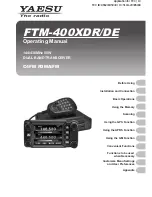
o
GROUND TERMINAL [GND] (p. 22)
Connect this terminal to a ground to prevent electri-
cal shocks, TVI, BCI and other problems.
!0
TUNER CONTROL SOCKET [TUNER] (p. 29)
Connect the control cable from an optional AH-4
hf/
50
mh
z
automatic
antenna
tuner
.
!1
DATA1 JACK [DATA1] (pp. 26, 168)
➥
Connect a PC through the optional OPC-1529R
data
communication
cable
, for low-speed data
communication in the DV mode. (p. 117)
➥
Connect a GPS receiver through the optional
OPC-1529R
data
communication
cable
, for
GPS operation. (p. 121)
!2
DATA2 SOCKET [DATA2] (pp. 26, 171)
Connect a TNC (Terminal Node Controller), etc. for
high speed data communications.
!3
STRAIGHT KEY JACK [KEY] (p. 24)
Connect a straight key or external electronic keyer
output using a standard
1
⁄
4
inch plug.
•
To use the internal electronic keyer for CW operation,
connect to [ELEC-KEY] on the front panel. (p. 1)
(
+
)
(
_
)
!4
ALC INPUT JACK [ALC] (p. 25)
Connect to the ALC output jack of a non-Icom linear
amplifier.
!5
SEND CONTROL JACK [SEND] (p. 25)
When transmitting, goes to ground to control an ex-
ternal unit, such as a non-Icom linear amplifier.
!6
ACCESSORY SOCKET [ACC]
Connect control lines for external equipment such
as a linear amplifier, an automatic antenna selector/
tuner, a TNC for data communications, etc.
• See page 13 for socket information.
!7
CI-V REMOTE CONTROL JACK [REMOTE]
(pp. 26, 183)
➥
Connect a PC, using the optional CT-17
ci
-
v
level
converter
, for external control of the transceiver.
➥
Use for transceive function with another Icom
CI-V transceiver or receiver.
When the transceive function is set to ON,
changing the frequency, operating mode, etc.
on the IC-9100 automatically changes those
settings on other Icom transceivers or receivers,
and vice versa. (p. 167)
➥
Connect another IC-9100, using a mini plug
cable*, for transceiver to transceiver cloning.
* Purchase separately
11
1
PANEL DESCRIPTION
!8
!6
!7
!5
!4
!3
!2
!1
o
■
Rear panel (Continued)
!0
















































